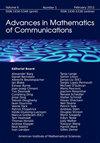On the correlation measures of orders $ 3 $ and $ 4 $ of binary sequence of period $ p^2 $ derived from Fermat quotients
IF 0.7
4区 计算机科学
Q3 COMPUTER SCIENCE, THEORY & METHODS
引用次数: 1
Abstract
Let \begin{document}$ p $\end{document} be a prime and let \begin{document}$ n $\end{document} be an integer with \begin{document}$ (n, p) = 1 $\end{document} . The Fermat quotient \begin{document}$ q_p(n) $\end{document} is defined as \begin{document}$ q_p(n)\equiv \frac{n^{p-1}-1}{p} \ (\bmod\ p), \quad 0\leq q_p(n)\leq p-1. $\end{document} We also define \begin{document}$ q_p(kp) = 0 $\end{document} for \begin{document}$ k\in \mathbb{Z} $\end{document} . Chen, Ostafe and Winterhof constructed the binary sequence \begin{document}$ E_{p^2} = \left(e_0, e_1, \cdots, e_{p^2-1}\right)\in \{0, 1\}^{p^2} $\end{document} as \begin{document}$ \begin{equation*} \begin{split} e_{n} = \left\{\begin{array}{ll} 0, & \hbox{if }\ 0\leq \frac{q_p(n)}{p} and studied the well-distribution measure and correlation measure of order \begin{document}$ 2 $\end{document} by using estimates for exponential sums of Fermat quotients. In this paper we further study the correlation measures of the sequence. Our results show that the correlation measure of order \begin{document}$ 3 $\end{document} is quite good, but the \begin{document}$ 4 $\end{document} -order correlation measure of the sequence is very large.由费马商导出周期$ p^2 $二元序列$ 3 $和$ 4 $阶的相关测度
设\begin{document}$ p $\end{document}为素数,设\begin{document}$ n $\end{document}为整数,其中\begin{document}$ (n, p) = 1 $\end{document}。费马商\begin{document}$ q_p(n) $\end{document}定义为\begin{document}$ q_p(n)\equiv \frac{n^{p-1}-1}{p} \ (\bmod\ p), \quad 0\leq q_p(n)\leq p-1。$\end{document}我们也定义\begin{document}$ q_p(kp) = 0 $\end{document} for \begin{document}$ k\in \mathbb{Z} $\end{document}。Chen、Ostafe和Winterhof构造了二元序列\begin{document}$ E_{p^2} = \left(e_0, e_1, \cdots, E_{p^2} \right)\in \{0,1 \}^{p^2} $\end{document}为\begin{document}$ \begin{equation*} \begin{split} E_{n} = \left\ \begin{array}{ll} 0, & \hbox{if}\ 0\leq \frac{q_p(n)}{p},并利用费马商的指数和估计研究了阶\begin{document}$ 2 $\end{document}的良好分布测度和相关测度。本文进一步研究了序列的相关测度。结果表明,序列\begin{document}$ 3 $\end{document}的相关测度相当好,而序列\begin{document}$ 4 $\end{document}的相关测度非常大。
本文章由计算机程序翻译,如有差异,请以英文原文为准。
求助全文
约1分钟内获得全文
求助全文
来源期刊

Advances in Mathematics of Communications
工程技术-计算机:理论方法
CiteScore
2.20
自引率
22.20%
发文量
78
审稿时长
>12 weeks
期刊介绍:
Advances in Mathematics of Communications (AMC) publishes original research papers of the highest quality in all areas of mathematics and computer science which are relevant to applications in communications technology. For this reason, submissions from many areas of mathematics are invited, provided these show a high level of originality, new techniques, an innovative approach, novel methodologies, or otherwise a high level of depth and sophistication. Any work that does not conform to these standards will be rejected.
Areas covered include coding theory, cryptology, combinatorics, finite geometry, algebra and number theory, but are not restricted to these. This journal also aims to cover the algorithmic and computational aspects of these disciplines. Hence, all mathematics and computer science contributions of appropriate depth and relevance to the above mentioned applications in communications technology are welcome.
More detailed indication of the journal''s scope is given by the subject interests of the members of the board of editors.
 求助内容:
求助内容: 应助结果提醒方式:
应助结果提醒方式:


